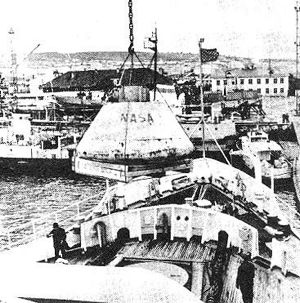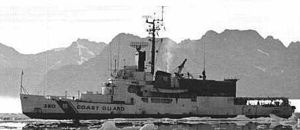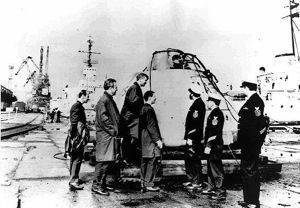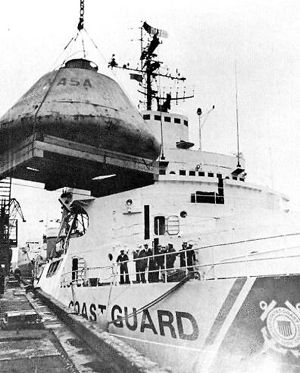|
|
Post by mcclellan on Oct 31, 2011 13:16:08 GMT -4
Thus we could straighten out the proportions so they would be 1 to 11, and we get the following image: Same basic photogrammetric error committed again. Please address the list I have composed dealing with the analysis you first posted. Who are you to demand that I should address your misconceptions? Of course, the proportions HAS TO BE 1:11, width 10 meters, length 110 meters. Or do you have any other ideas? Are you aware of the fact that the visible WIDTH doesn't change with the angle? If the width is 10 meters seen from the side, then it would be 10 meters if we looked into the tail of the rocket. Learn this simple principle, and you will understand a whole lot more. |
|
|
|
Post by JayUtah on Oct 31, 2011 13:18:27 GMT -4
Wrong interpretation. I have reliable information that shows that Saturn V did't get into orbit. No. You have a candidate analysis that you claim shows the Saturn V lacked the power to get to orbit. The validity of that analysis has been challenged on several grounds that you believe you have addressed, but have not. You have provided no evidence that the Saturn V actually failed to get to orbit; you simply infer that outcome from your favored analysis. There is extensive photography and film of Saturn V assembly. There are two remaining Saturn Vs disassembled and available for public inspection. You're the one mixing them. You brought up the hypothesis of short-fueling the vehicle, therefore you're responsible to defend it. The Saturn V is the most studied rocket in the history of rocketry, which now encompasses tens of thousands of practitioners and four generations of practice. Upon what basis do you propose to challenge an entire industry? |
|
|
|
Post by JayUtah on Oct 31, 2011 13:21:06 GMT -4
Who are you to demand that I should address your misconceptions? The person whose statements you claim have all been addressed. Have you studied the science of photogrammetry? Please answer with the single word "yes" or "no". |
|
|
|
Post by mcclellan on Oct 31, 2011 13:30:20 GMT -4
So that's good for you that you are a "professional engineer working in aerospace", you have my fullest respect for that. But I still claim that you have misunderstood all the velocity calculations. Your faith in NASA is greater than your sense. What about his ability to tell if rockets fall down? Do you respect that? Because if NASA's information is wrong, that's what would happen. Are you aware of this?: www.astronautix.com/articles/sovpsule.htm BP-1227 Hoisted BP-1227 Hoisted
The picture that clinched it. Tamas Feher discovered this photo of the 'recovery of an Apollo capsule' in a Hungarian space history book. It actually depicts Apollo BP-1227 being lowered to the deck of the USCG Southwind in Murmansk, USSR, 1970.
Credit: Tamas Feher Southwind Southwind
The USCG Icebreaker that received an Apollo capsule from the Soviet Union at Murmansk, 1971.
Credit: US Coast Guard BP-1227 Handover BP-1227 Handover
The picture that started it all. Nandor Schuminszky found this Hungarian press photo from 1971, with the caption that it depicted the handover of an American Apollo capsule from the Soviet Union to the USA on September 8, 1970 in Murmansk.
Credit: Nandor Schuminszky BP-1227 Loaded BP-1227 Loaded
Apollo BP-1227 is lifted from the pier at Murmansk onto the USCG Southwind, September 8, 1970. From the ship's cruise book.
Credit: Mike MaloneNote: this happened in "early 1970". Did NASA have any Apollo missions during that period? Well, yes they did - the "famous" Apollo 13. Launched on April 11, 1970. "Early 1970", huh? |
|
|
|
Post by JayUtah on Oct 31, 2011 13:36:38 GMT -4
Are you aware of the difference between a boilerplate Apollo test article and a flight-qualified command module? Did you read the article that says the FTA had gone missing a year before Apollo 13? I'm wondering who you expect to believe that those could possibly be the same spacecraft. |
|
|
|
Post by chew on Oct 31, 2011 13:40:49 GMT -4
The others have already been covered in this thread. Have they? Wrong again. We haven't discussed the Mach cone method, or have we? First, the wake angle formed by a moving boat is constant regardless of speed so I don't know why you included that picture. Second, have you applied this method to your previous exhaust plot (that red dot thingy)? Third, that's too jagged to be a Mach cone. |
|
|
|
Post by tedward on Oct 31, 2011 13:43:31 GMT -4
[ But... I don't have any reliable information on HOW IT WAS CONSTRUCTED. This we can not know, as none of us was allowed to look inside Saturn V. How many rockets have you examined? Not sure I could go up to ESA and ask to see inside one of their toys. BTW, you deviating from your bone? |
|
|
|
Post by gillianren on Oct 31, 2011 13:48:31 GMT -4
It's irrelevant to my point. If the data provided by NASA is incorrect, rockets built using it won't work. Which means anyone using that data would know the rockets didn't work. No devotion to NASA would be able to convince them otherwise. Just be grateful I'm not making scathing historical references about people who can't count, which would be quite easy, given your screen name. |
|
|
|
Post by echnaton on Oct 31, 2011 13:50:29 GMT -4
But... I don't have any reliable information on HOW IT WAS CONSTRUCTED. This we can not know, as none of us was allowed to look inside Saturn V. It is incredible to me that one could in the same breath claim that one didn't know how Saturn 5 was built and that it couldn't have made orbit. See my sig line for a further explanation. I've "looked inside" a flight certified Saturn 5 rocket personally. It's on public display at the Johnson Space Center, free of charge. That you haven't taken the opportunity to seek out the relevant information for the rocket casts further doubt on your willingness to face facts. Many hundreds of people were engaged in constructing and inspecting the flown Saturn 5 rockets. If you are going to impugn their skills and knowledge it really should be based on more than a few calculations you don't understand. |
|
|
|
Post by mcclellan on Oct 31, 2011 13:51:44 GMT -4
Are you aware of the difference between a boilerplate Apollo test article and a flight-qualified command module? That's what NASA says, right? And we should take their words for granted, or should we not? Did you read the article that says the FTA had gone missing a year before Apollo 13? No. Do you have any further information about that? Any link or so? I'm wondering who you expect to believe that those could possibly be the same spacecraft. I don't claim that it was so, only that it could have been so. The slow-flying Apollo rockets may well have landed in the mid-Atlantics somewhere much closer the US East coast, but far enough from the spectators so that they wouldn't see this "diving event". |
|
|
|
Post by mcclellan on Oct 31, 2011 13:53:41 GMT -4
[ But... I don't have any reliable information on HOW IT WAS CONSTRUCTED. This we can not know, as none of us was allowed to look inside Saturn V. How many rockets have you examined? Not sure I could go up to ESA and ask to see inside one of their toys. None. How many have you examined? BTW, you deviating from your bone? And you wanted to say... what? |
|
|
|
Post by mcclellan on Oct 31, 2011 14:00:40 GMT -4
But... I don't have any reliable information on HOW IT WAS CONSTRUCTED. This we can not know, as none of us was allowed to look inside Saturn V. It is incredible to me that one could in the same breath claim that one didn't know how Saturn 5 was built and that it couldn't have made orbit. See my sig line for a further explanation. I've "looked inside" a flight certified Saturn 5 rocket personally. It's on public display at the Johnson Space Center, free of charge. That you haven't taken the opportunity to seek out the relevant information for the rocket casts further doubt on your willingness to face facts. Many hundreds of people were engaged in constructing and inspecting the flown Saturn 5 rockets. If you are going to impugn their skills and knowledge it really should be based on more than a few calculations you don't understand. You are simply marking my words, that's it. I see no substantial counter-arguments from you. It's irrelevant whether we do or do not know how the Saturn V rocket was constructed. The only relevant thing is that we know that it flew too slow, much slower than NASA told us that it did. And to that end I haven't seen any models which would prove that the calculations presented here are faulty. I see plenty of empty words, but no convincing evidence that would prove NASA:s declared velocities. |
|
|
|
Post by chew on Oct 31, 2011 14:09:17 GMT -4
I don't claim that it was so, only that it could have been so. The slow-flying Apollo rockets may well have landed in the mid-Atlantics somewhere much closer the US East coast, but far enough from the spectators so that they wouldn't see this "diving event". The boilerplate was recovered in the North Sea. You are claiming it was the Apollo 13 Command Module. Do you have any idea how much delta-v would be required for a plane change for a launch due east from KSC to the North Sea??? Hint: it's a lot more than just reaching orbit, which you claim the Saturn V could not attain. |
|
|
|
Post by JayUtah on Oct 31, 2011 14:12:48 GMT -4
We haven't discussed the Mach cone method, or have we? Yes we have, and the discussion is linked from this thread. Did you read the thread before you posted in it? Someone tried to analyze the Mach wave from the SLA, but managed to commit a related photogrammetric error in the process and so came up with the wrong value for the angle. No. Using the Mach angle you can determine the local Mach number of any flying object. Translating that to speed requires additional computation and variables that have their own error analysis problems. Your author, as has been noted, wrongly conflates the idea of a hydrodynamic surface wake with the idea of a Mach wave. The two can't possibly have any less to do with each other. For starters, one relies on compressible flow while the other does not. The feature identified in your illustration as the Mach wave is, in fact, simply combustion products drawn upward along the lower-pressure zone behind the bow shock wave. As noted, it is to soft-edged to be a Mach wave. Further, it is visible here without any special optical processing ordinarily required to reveal Mach waves. Further, there should be zones of Prandtl-Meyer expansion at the CM/SM boundary, the SLA/S-IVB boundary, and the adapter/S-IC boundary -- none of which are visible here. The rectification has been performed incorrectly. |
|
|
|
Post by JayUtah on Oct 31, 2011 14:16:41 GMT -4
That's what NASA says, right? And we should take their words for granted, or should we not? No, that's what I observe. It was in the article you cited. You seem to think we are just relying on NASA to tell us what to believe. You seem unconvinced that there are people on this forum, and in the world at large, whose knowledge of rocketry is sufficient for them to identify a flawed line of reasoning using only their own expertise. Aren't you, in fact, simply putting your faith in these Russian sites? What have you personally done to verify that they're correct? I've asked you a couple of times what your personal qualifications are in the relevant field. I can only conclude from your silence that you don't have any, but you aren't willing to admit that here. |
|